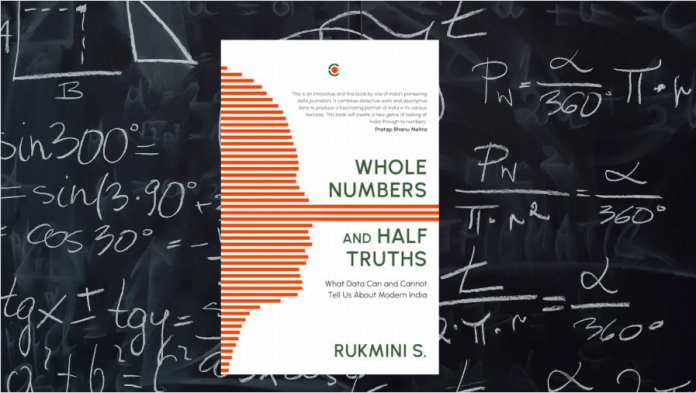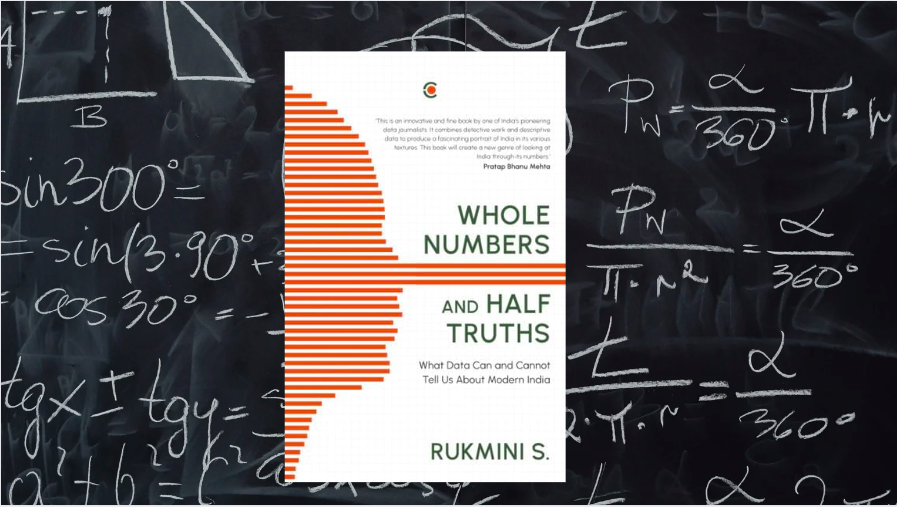Whole Numbers And Half Truths: What Data Can And Cannot Tell Us About Modern India
by Rukmini S.
Publisher: Context (2021)
For a book of non-fiction, dealing primarily with numbers and graphs of all kinds, Whole Numbers And Half Truths by Rukmini S. almost reads like a thriller. The very first chapter (‘How India Tangles With Cops and Courts’) sets the pace, revealing some uncomfortable and shocking truths about crime in India. The data elicits an eagerness in the reader, the desire to know what will be unveiled next. Successive chapters carry forward this narrative, revealing eye-opening details that sometimes fill you up with hope and other times bring you down with gloom.
The author, a seasoned data journalist, uses data from both government as well as private sources to interpret various aspects of the modern Indian life: religion, politics, jobs, health, among others. Interspersed with these statistical materials (for which there are references at the end of the book) are anecdotes and quotes from a varied selection of the population. These ‘asides’ add warmth to the book, humanising the cold, hard numbers and showing us the complex feelings and beliefs that bind this diverse nation together.
In ‘What India Thinks, Feels and Believes’, for instance, the general, liberal veneer of India is carefully removed to show the conservative heart that beats at the centre. Everything depends on how the query is framed to the responders – and Rukmini shows us how specific lines of questioning are better suited to shed light on what the citizens truly stand for.
But even then, some answers can be quite complicated. Although ‘development’ is often believed to be the main point of contention during elections – which political party promises more schemes and dreams – the surveys cited in the chapter ‘How India (Really) Votes’ suggest that people use a “much more complex decision matrix to arrive at decisions.”
Decisions and beliefs aside, Whole Numbers And Half Truths also touches upon the sensational nature of Indian media, all the suffering Covid-19 brought into our lives, as well as, of course, the deficiencies of data collected in India.
An ever-present thread in every chapter, the problem with data is boiled down to a “combination of neglect, discredit and dismissal” in ‘Conclusion’. It doesn’t help, as Rukmini explains in ‘Introduction’, that “statistics can be unintelligible, out of date, hard to find, and harder still to communicate.” There is a desperate need, too, for context and interpretation, which she so beautifully illustrates in the data she translates in the book.
The book’s cover too (subtly) draws our attention to the importance of data. Bundled away towards the end, a note explains that the “Pinocchio within a bar chart” on the front jacket is intentional. “Evoking the colours of the national flag, it adds a human face to impassive numbers as a reminder of what they ultimately represent. The face wraps around the book, but it is the spine that shows where this work truly lies: filling in the gaps between the data.”
And fill the gap it does. Whole Numbers And Half Truths bares open the misunderstandings, misinformation, and mistakes of modern India and implores us to go beyond the numbers at the surface and seek out the truth of ideas, beliefs, and motivations.






RELATED ARTICLESMORE FROM AUTHOR
Last Among Equals: Power, Caste & Politics in Bihar’s Villages
Desperately Seeking Shah Rukh: India’s Lonely Young Women and the Search for Intimacy and Independence
The Nutmeg’s Curse: Parables for a Planet in Crisis